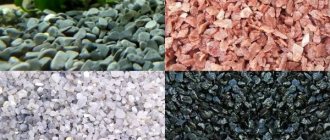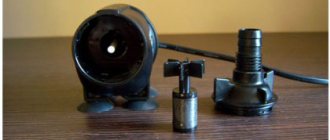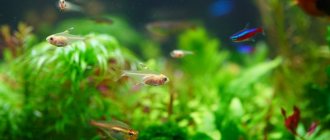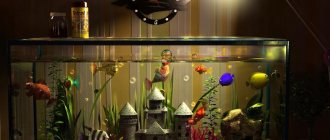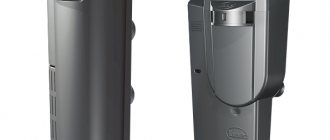A filter is a must-have accessory in any aquarium. It not only purifies the water from harmful substances and toxic waste from fish, but also saturates it with oxygen. But during operation, the device becomes clogged, its efficiency decreases and dangerous toxins are released into the water.
In order for the filter to work properly and perform all its functions fully, you need to clean it regularly. It is important to do this correctly, since bacteria live on the surface of the filter materials, which maintain the biobalance in the artificial reservoir.
With all the variety of models, both internal and external filters have approximately the same structure. Therefore, this instruction on how to clean the filter in an aquarium will be useful to any aquarist.
How often should you clean your aquarium filter?
Each aquarium is individual, and the frequency of filter cleaning depends on many factors:
- aquarium size;
- filter model: its size and power;
- chemical composition of water;
- degree of forest cover of an artificial reservoir;
- frequency of fish feeding;
- the presence of living plants that serve as a biological filter.
Taking into account all the conditions, you need to observe how often the device becomes clogged and wash it as it gets dirty. The signal can be a stream of water - it noticeably weakens when washing is necessary. On average, internal filters need to be washed once every two weeks, while external filters can remain clean for a month to two. The difference is that external devices are usually larger in volume, therefore there will be more filler there.
What determines the frequency of maintenance of an aquarium filter?
It is common for novice aquarists to make mistakes in their pond care schedule. Rare cleaning, as well as too frequent cleaning, is harmful to the aqua system and can cause problems. Factors influencing the frequency of aquarium maintenance:
- Aquarium volume. Ponds that are too small need to be cleaned more often than large ones, because in large aquariums the aquatic system is more stable.
- Number of living fish. The more inhabitants there are, the more often you will have to clean it. By adding more feed, waste increases.
- Number of natural plants. Living plants serve as a biological filter for the aquatic system. They are involved in processing waste, absorbing harmful substances, and cleaning the reservoir.
- Bacteria. This is the basis of biological filtration. They are engaged in primary waste processing. Their action affects the stability of the aquatic system.
- Filtration. The filter is selected according to the volume of the aquarium. The installed mechanism must be able to cope with the volume of waste and create a sufficient level of water circulation. The frequency of treatment of the aquarium filter depends on how the filtration is performed.
- Feeding. The reservoir is also polluted due to overfeeding of fish. Feeding is best done in moderation.
- Failure to maintain the correct aquarium maintenance regime. Due to excessive lighting, walls and decorations become dirty, and problems with algae appear. Excessive application of fertilizers leads to this effect.
For continuous filtration, a constant flow of oxygen is required to the filter material. Interruptions in the supply of oxygen, which is dissolved in water, can occur due to two circumstances:
- If the filter material is not cleaned from mechanical contamination in a timely manner. Excess dirt interferes with the flow of oxygen and saprophytes (plant organisms that feed on dead organic matter) do not decompose organic matter as they should.
- Interruptions in the functioning of the aquarium filter. If there is no oxygen supply, beneficial bacteria will die off. Due to prolonged stoppages in the operation of the filter, colonies of microorganisms will die. Such a situation will lead to reverse processes in the filter, and the dead saprophytes will begin to release toxic substances into the water: hydrogen sulfide, methane, ammonia and carbon dioxide. If a filter that does not work for a long time is connected, streams of contaminants with an unpleasant odor will flow into the water, poisoning the inhabitants of the aquarium.
Types of filtering
- Mechanical. Water passes through porous sponges and is cleared of suspended matter, feed residues and other large particles. To ensure that the quality of filtration does not decrease, the sponges must be washed and periodically replaced.
- Biological. During the life of fish, ammonia and nitrates are released into the water, which can poison aquatic inhabitants. This type of filtration reduces the amount of such substances. The bacteria that live in the filter decompose them into safe components.
- Chemical. Used for mass poisoning of fish in an aquarium - only after treatment. At such moments, activated carbon is used as a filter material, the particles of which retain harmful substances.
Is cleaning necessary?
The aquarium filter must be cleaned, regardless of its type and features.
By passing water through itself and purifying it, it gradually becomes more and more polluted. The filter material, tubes, impeller and other parts become clogged with filtered dirt, remnants of decaying organic matter, and harmful substances. This causes the filter's efficiency to decrease over time.
At some point, it stops purifying and begins to release dangerous toxins into the water. This leads to severe disturbances in the biological balance of the aquarium and all kinds of diseases of its inhabitants.
How to properly clean the filter
Depending on the degree of contamination, you can clean only the filter materials (filler), or the filter as a whole (its mechanical parts). To wash the filler, just rinse it thoroughly in water. It's better if it comes from an aquarium. Complete cleaning should be carried out when plaque prevents the device from performing its functions.
Do not try to keep the device sterile and do not use detergents. This will destroy beneficial bacteria and thereby disturb the bioenvironment in the aquarium.
Complete cleaning is not recommended when changing water or introducing new inhabitants. The best timing would be the time between changing the water in the aquarium, as the filter maintains biological balance.
To wash the internal apparatus, it must be removed from the aquarium and disassembled. Rinse all components under running (but not hot) water. Clean the inner walls of the filter using cotton swabs. Clean the air intake adapter (you can use a needle for this). After which the filter is collected and put back.
If an external filter unit is installed in the aquarium, it is removed and also disassembled. All baskets are washed one by one. Mechanical components must be cleaned of mucus. Everything is put together in reverse order.
When cleaning, pay special attention to the impeller. An impeller is a cylindrical magnet with an impeller that serves to create a flow of water. Contamination is the most common cause of filter failure. To clean, you need to remove it from the pin on which it is attached and rinse with water.
Devices need to be disassembled and reassembled as quickly as possible in order to cause less damage to bacterial colonies.
What to do with the inhabitants during this period?
Considering that the filter is removed from the aquarium for cleaning, this event will not disturb the inhabitants in any way. They can be left inside to avoid unnecessary stress.
Another aspect is that after a serious cleaning, the filter bacteria will take some time to master the filter medium and begin to work normally.
In order to facilitate and speed up this process, it is recommended to reduce the load on the filter. The easiest way is to slightly reduce the fish’s diet the day before cleaning the filter. Then - gradually return to your normal diet over 4-6 days.
Replacing the filter
If cleaning the filter does not help, the filter material in it should be replaced. Usually the need for replacement arises after at least a year - the sponge loses its shape and filtering ability.
In order not to greatly harm the biological environment, the filter material should be changed gradually - in parts. By taking breaks, you will give bacteria from old surfaces the opportunity to colonize new ones faster.
If you notice that the filter works poorly, makes a lot of noise and vibrates, check the operation of the impeller. The part should rotate evenly and without interruption. Otherwise, replacement will be required.
To ensure the device operates efficiently, observe its operation. Clean the filter regularly - the frequency is individual and depends on various factors in your aquarium.
How to understand that it is not cleaning that is needed, but replacement or repair?
When the filter begins to work weakly, intermittently, or does not work at all, and cleaning does not give any results, we can conclude that it is broken. To make sure of this, you can turn it off, remove it from the aquarium and conduct a thorough inspection.
First of all, it is recommended to check the wires (especially at the output of the device). Often, during long-term use, their shell is damaged, they spark, which can lead to dangerous consequences. In this case, the device needs simple but urgent repairs.
During inspection, special attention should be paid to the appearance and operation of the impeller. It should spin evenly, without interruption and without any damage. Otherwise, you cannot do without repairing or replacing this part.
IMPORTANT! A breakdown of the impeller (and, accordingly, the entire filter) is also indicated by strong noise, rumble and vibration during filter operation.
Suspicion should be caused by external damage to any parts of the filter system and an unpleasant burning smell.
Any aquarium is a complex ecosystem, the balance of which can easily and irreparably be disrupted by illiterate care. The filter is an important element of this system. Timely cleaning and inspection will ensure its correct operation for many years and avoid serious troubles.
Other interesting articles
- How to make a bottom filter for an aquarium with your own hands Bottom filters are cleaning devices that filter water naturally, passing it through the soil. The design has…
- Large, medium and small peaceful fish for the aquarium Among various types of pets, aquarium fish are especially popular. They are relatively inexpensive, not...
- Fillers for an external filter for an aquarium, which ones are better Filtration of aquarium water is a paramount issue. The well-being of aquarium inhabitants depends on it, so it’s natural that...
Cleaning the walls
First of all, let's look at how to clean the walls of an aquarium.
Be sure to turn off all electrical equipment!
In absolutely any aquarium, over time, a coating forms, both limescale - from poor quality water, and green - due to the presence of algae. It is precisely these, not very pleasant factors, that we will encounter sooner or later. Internal pollution makes glass and water cloudy and, as a result, unsuitable for your pets to live in.
First, you should thoroughly wash the aquarium glass.
What is needed for this
First of all, you need to learn how to properly clean an aquarium, because the appearance of the fish house entirely depends on this.
This can be done using the following devices:
- special scrapers with a metal blade
- nylon sponges
- regular kitchen sponges
Let’s tell you a little secret: “You don’t need to wait until the walls are covered with a cloudy coating.”
Periodicity
Make it a rule to wipe the glass of the aquarium at least once a week, even if at first glance they seem clean. This procedure is much simpler than washing cloudy glass that was two or three weeks old.
- If you decide to clean the walls of the aquarium without removing its inhabitants, then the use of any detergents is strictly prohibited.
- If you are planning a planned cleaning with the relocation of its inhabitants, then for this you can use a special washing sample of potassium permanganate solution.
It is with the help of these rules that you can easily wash off plaque of almost any complexity.
Procedure for cleaning algae and decorative elements
In order to make the aquarium unique and create comfortable conditions for its inhabitants, various decorations are used - shells, large stones, ships, houses, artificial algae. These items are also covered with algae and traces of fish activity, so they require regular cleaning.
To maintain order in the tank, periodically weed out live algae and remove damaged parts of plants
Procedure for cleaning the decorations:
Remove items that require cleaning from the tank. Rinse items with warm running water. Use an old toothbrush and baking soda to remove plaque.
It is important to thoroughly wash all surfaces, remove plaque and dirt. Rinse the decorations with clean water and place them in the tank.
Signs of dirty filter elements
Filter models are different and devices for small aquariums need to be cleaned more often than those for large ones. When determining contamination, you need to take a closer look at the water flow from the device. If the flow becomes weaker, then this is a sign that flushing is required. If the water in the reservoir becomes cloudy, this also serves as a signal that the filter is dirty.
How to clean an aquarium?
To do this you will need a certain set of tools. Detergents are used every few cleanings. In addition, you need clean, fresh water and a container where you can place the aquarium inhabitants and plants.
Aquarium cleaning tools
- First of all, you will need a net. They catch flora and fauna.
Interesting fact: a small net is easier to manipulate in the water, a larger one is easier to catch fish. The choice of net depends on personal convenience.
- To clean the walls you need a special scraper. Different materials require different scrapers; there are separate types for cleaning corners and stubborn dirt. You need a set of several scrapers or a universal tool with interchangeable attachments. This will allow you to achieve better cleanliness and ensure the prevention of various diseases.
- To clean the soil from waste, a siphon is needed. This is a specially designed container with a hose. The soil is scooped up with a siphon, water and waste flow down the hose, and heavier materials remain in place.
- A bucket, preferably several, is used in different ways. Dirty water is poured into it and clean water is poured out of it. You can put fish in it while cleaning. The bucket into which the aquarium is drained should be used only for this purpose, so that toxic substances do not get anywhere else.
Detergents
There is often advice to use bleach or “whiteness”.
Attention! It is prohibited to wash the aquarium itself with them! Getting even a small amount of such products into the water will kill all the fish. Bleach is used in exceptional cases and only for cleaning decorations.
A less dangerous analogue is hydrogen peroxide. The ideal solution is plain water. Only it definitely won’t harm the inhabitants. For particularly difficult stains, boiling water is used.
Baking soda, potassium permanganate, and washing powder solution are used to disinfect the tank.
It is acceptable to use chemical cleaners on the outer walls of the aquarium. The procedure should be performed carefully and carefully. Special napkins for glass and napkins for monitors are also suitable.
